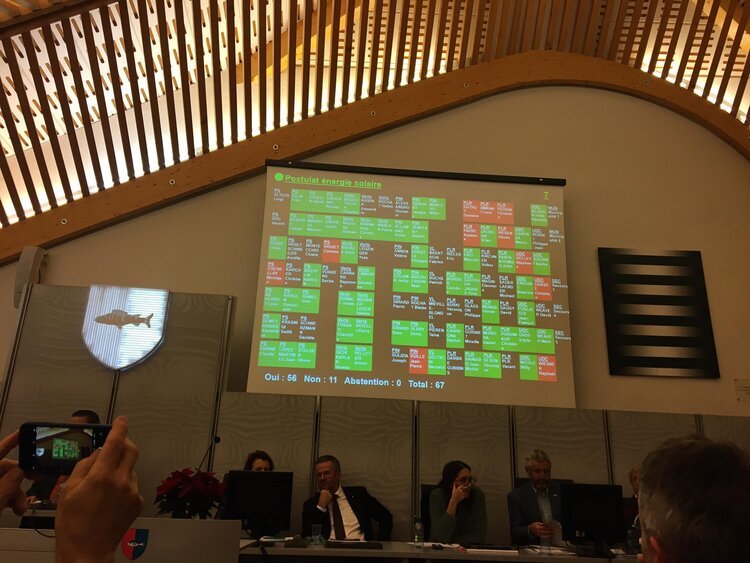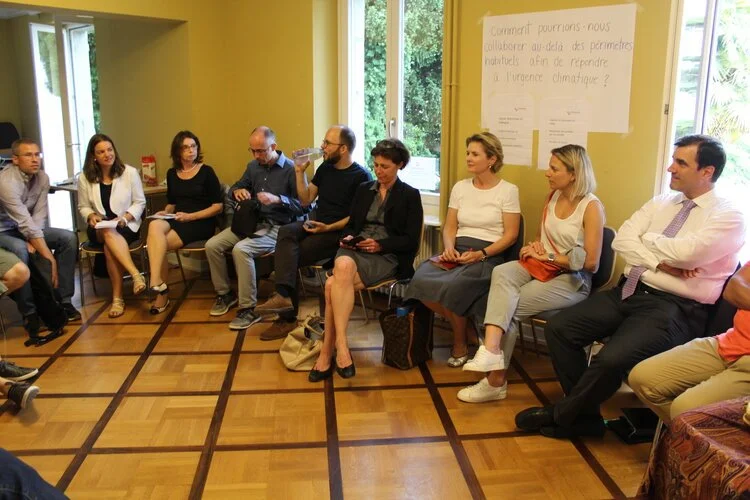The power of dialogue to transform local climate politics
This photo shows the voting record of a recent cross-party proposal for a solar energy plan in a town in Vaud. Unlike many other votes before it, this small but important action was voted straight through by a large majority. What was so different about this proposal? The solar energy plan was developed from the beginning with participation from all political parties. This would have been unimaginable less than a year earlier, so how did such a rapid change come about?
This is the story of a facilitator who recognised and stepped into her role as a change agent. It is also a practical guide to inspire fellow process facilitators to reach out and support a different type of politics in their local area.
The first step is always the hardest
A British-European living in Switzerland, the Brexit result triggered a desire in me to apply the dialogue skills acquired through my day job to help connect communities and improve democracy more locally. Through connections in the Art of Hosting community (thanks Sidsel!), I found my tribe in a young Swiss association, collaboratio helvetica. I joined my first Dialogue Evening with them about a year ago. When invited at the end to check out with a tiny action to make a big change, I committed to send messages to a few contacts involved in local politics to ask if they were experiencing issues that would benefit from a facilitated dialogue approach. No one responded! I persevered and my ex-colleague Elise Buckle thankfully responded to my reminder.
Elise is a well-connected local councillor with the Green Party in Nyon, who is passionate about climate change (key ingredients for our change champion). When I reached out to her, the climate strikes were in full march and Nyon was planning to declare a climate emergency, but Elise worried that traditional political divisions plus the formal debating style in the Council would block constructive action, as had recently happened over a referendum on finances. We discussed how it would be better to develop a plan from the bottom up, together with all parties, to avoid wasted energy and wasted time. This hadn't been done before and a different approach was needed, which is where the idea of the first dialogue on climate in Nyon was born.
While it took courage to take these first steps, from there momentum took over as the team of allies and expectations grew. Collaboratio helvetia provided support at the first dialogue in the context of their work with municipalities (thanks especially to Erica for co-hosting)! Twenty councillors across almost all of the political parties came to the first dialogue, representing more than a fifth of all councillors. Some councillors shared their surprise that an event “could produce such conversations”, while others expressed a desire to “practice all politics in such a human way”.
Principles of Dialogue
Now, five dialogues later, more than a quarter of all councillors have participated in at least one dialogue, and from across all parties. The first joint proposal has been voted through on the solar plan. The second joint proposal came swiftly after the first dialogue of 2020. In the context of discussions on mobility, the group identified a quick win: sending a copy of the cycling route map to every household in Nyon. This proposal was also supported with a large majority and the City Council has already responded positively.
Furthermore, the principles of dialogue (see photo), which have been repeatedly shared since the first dialogue, have become part of the proposed TORs for a more formal inter-party committee on climate. There is still a long way to go, but the foundations are in place for an active and impactful future!
Practically speaking, how to create an inter-party group on climate?
Our aim was to create a different way of sharing and hearing, to be more authentic and share personal experiences. The group also validated a shared desire to respond to the climate emergency, to go beyond traditional institutional barriers and work together towards the common good, even if there were different views on how to get there (dialogue 1). To do so, it was important to not get bogged down in defining objectives and a work plan but to open up and hear what themes were most relevant for the participants (dialogues 2 and 3), and to build on those areas to identify first actions to build trust, and to build confidence in the process and each other (dialogues 4 and 5). The group has a few more themes to work through, as well as discussing what the next phase could look like, particularly on how best to continue to work together in the future. Here are the steps that we have taken so far (which should be taken as a guide and not a specific road map).
Dialogue 1: Setting the scene
We had three hours in a stunning venue next to Lake Geneva. Each councillor received an individual and attractive invitation with the question: “how can we collaborate beyond our usual perimeters in order to respond to the climate emergency” . Councillors arrived to a room set out in a circle of chairs, with the principles of dialogue written up on a flip chart on the wall. After an introduction to the objectives and how circle check-ins work, participants were invited to share their name and any information they thought could be relevant (not necessarily their party affiliation) as well as a response to the check-in question: “why did you say yes to the invitation to come to this dialogue on climate?”.
Dialogue 1: Setting the scene
Despite the stormy June evening, we persevered with the “Dialogue Walk”, encouraging participants to exchange with someone they didn't know so well. In pairs, participants shared why climate issues were important to them personally and their hopes and fears for the future. The group then broke into trios, where the first participant asked another what was emerging, and any particular personal actions they'd like to take forward, while the second responded, the third person wrote as they spoke, and was therefore able to immediately offer a record of the dialogue to aid action. In checking out, we simply asked what they had most appreciated about the dialogue so far.
Dialogues 2 and 3: being open to what is emerging
In the next two dialogues, smaller groups of participants met in circle around a picnic by the lake and continued to practice sharing from their personal perspectives, listening deeply and not jumping to conclusions. Dialogue 2 focused on personal barriers to taking action, and successes. Dialogue 3 focused on opportunities for quick wins, by which stage a number of recurrent themes had started to bubble to the surface and the group was ready to start to move towards identifying actions.
Dialogues 4 and 5: understanding barriers and identifying tiny, targeted actions
As usual, we started with a circle check-in. Then rather than forcing discussion in particular areas, we followed the group's energy for those present that evening, each time using "dotmocracy" voting to prioritise four out of seven potential areas for further discussion. These were then worked through using pro-action café methodologies, to have three rounds of questions, focusing on the situation and the challenges, the change desired and the current barriers, and potential ways forward. And of course, ensuring a checkout at the end, in this case asking for just three words. To quote just one participant: “J’suis très motivé!”
Your next step?
This experience is a demonstration of how the creation of a space for “conversations that matter” can lead to change in systems, one dialogue at a time. If you're inspired by this example, you can learn and practice similar techniques at Art of Hosting events (including the annual Art of Participatory Leadership workshop just outside Geneva in March) and of course through collaboratio helvetica in Bern.
Written by Nadine McCormick



